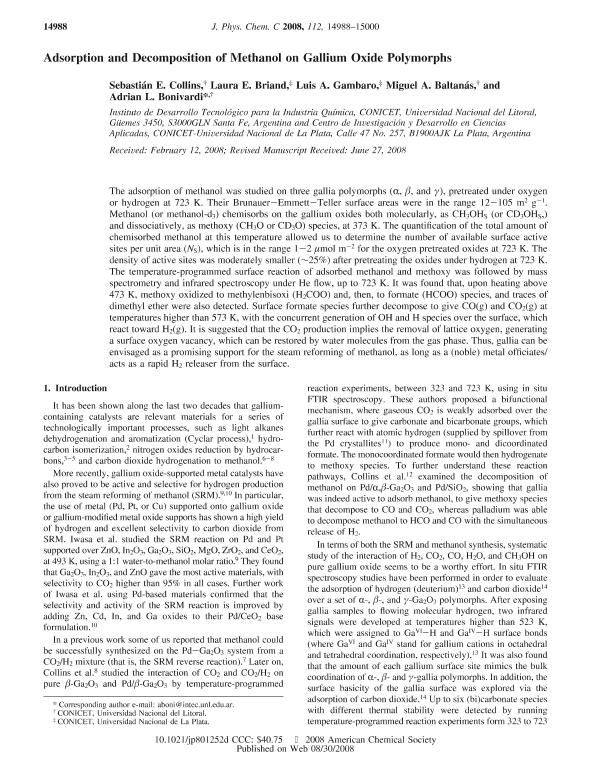Mostrar el registro sencillo del ítem
dc.contributor.author
Collins, Sebastián Enrique

dc.contributor.author
Briand, Laura Estefania

dc.contributor.author
Gambaro, Luis Alberto

dc.contributor.author
Baltanas, Miguel Angel

dc.contributor.author
Bonivardi, Adrian Lionel

dc.date.available
2017-07-06T19:03:10Z
dc.date.issued
2008-12
dc.identifier.citation
Collins, Sebastián Enrique; Briand, Laura Estefania; Gambaro, Luis Alberto; Baltanas, Miguel Angel; Bonivardi, Adrian Lionel; Adsorption and decomposition of methanol on gallium oxide polymorphs; American Chemical Society; Journal of Physical Chemistry C; 112; 38; 12-2008; 14988-15000
dc.identifier.issn
1932-7447
dc.identifier.uri
http://hdl.handle.net/11336/19781
dc.description.abstract
The adsorption of methanol was studied on three gallia polymorphs (alpha, beta, and gamma), pretreated under oxygen or hydrogen at 723 K. Their Brunauer-Emmett-Teller surface areas were in the range 12-105 m2 g-1. Methanol (or methanol-d3) chemisorbs on the gallium oxides both molecularly, as CH3OHS (or CD3OHS,) and dissociatively, as methoxy (CH3O or CD3O) species, at 373 K. The quantification of the total amount of chemisorbed methanol at this temperature allowed us to determine the number of available surface active sites per unit area (NS), which is in the range 1-2 µmol m-2 for the oxygen pretreated oxides at 723 K. The density of active sites was moderately smaller (~25%) after pretreating the oxides under hydrogen at 723 K. The temperature-programmed surface reaction of adsorbed methanol and methoxy was followed by mass spectrometry and infrared spectroscopy under He flow, up to 723 K. It was found that, upon heating above 473 K, methoxy oxidized to methylenbisoxi (H2COO) and, then, to formate (HCOO) species, and traces of dimethyl ether were also detected. Surface formate species further decompose to give CO(g) and CO2(g) at temperatures higher than 573 K, with the concurrent generation of OH and H species over the surface, which react toward H2(g). It is suggested that the CO2 production implies the removal of lattice oxygen, generating a surface oxygen vacancy, which can be restored by water molecules from the gas phase. Thus, gallia can be envisaged as a promising support for the steam reforming of methanol, as long as a (noble) metal officiates/ acts as a rapid H2 releaser from the surface.
dc.format
application/pdf
dc.language.iso
eng
dc.publisher
American Chemical Society

dc.rights
info:eu-repo/semantics/openAccess
dc.rights.uri
https://creativecommons.org/licenses/by-nc-sa/2.5/ar/
dc.subject
Methanol
dc.subject
Adsorption
dc.subject
Gallia
dc.subject.classification
Otras Ciencias Químicas

dc.subject.classification
Ciencias Químicas

dc.subject.classification
CIENCIAS NATURALES Y EXACTAS

dc.title
Adsorption and decomposition of methanol on gallium oxide polymorphs
dc.type
info:eu-repo/semantics/article
dc.type
info:ar-repo/semantics/artículo
dc.type
info:eu-repo/semantics/publishedVersion
dc.date.updated
2017-06-29T13:36:20Z
dc.journal.volume
112
dc.journal.number
38
dc.journal.pagination
14988-15000
dc.journal.pais
Estados Unidos

dc.journal.ciudad
Washington
dc.description.fil
Fil: Collins, Sebastián Enrique. Consejo Nacional de Investigaciones Científicas y Técnicas. Centro Científico Tecnológico Conicet - Santa Fe. Instituto de Desarrollo Tecnológico para la Industria Química. Universidad Nacional del Litoral. Instituto de Desarrollo Tecnológico para la Industria Química; Argentina
dc.description.fil
Fil: Briand, Laura Estefania. Universidad Nacional de La Plata; Argentina
dc.description.fil
Fil: Gambaro, Luis Alberto. Universidad Nacional de La Plata; Argentina
dc.description.fil
Fil: Baltanas, Miguel Angel. Consejo Nacional de Investigaciones Científicas y Técnicas. Centro Científico Tecnológico Conicet - Santa Fe. Instituto de Desarrollo Tecnológico para la Industria Química. Universidad Nacional del Litoral. Instituto de Desarrollo Tecnológico para la Industria Química; Argentina
dc.description.fil
Fil: Bonivardi, Adrian Lionel. Consejo Nacional de Investigaciones Científicas y Técnicas. Centro Científico Tecnológico Conicet - Santa Fe. Instituto de Desarrollo Tecnológico para la Industria Química. Universidad Nacional del Litoral. Instituto de Desarrollo Tecnológico para la Industria Química; Argentina
dc.journal.title
Journal of Physical Chemistry C

dc.relation.alternativeid
info:eu-repo/semantics/altIdentifier/doi/http://dx.doi.org/10.1021/jp801252d
dc.relation.alternativeid
info:eu-repo/semantics/altIdentifier/url/http://pubs.acs.org/doi/abs/10.1021/jp801252d
Archivos asociados
